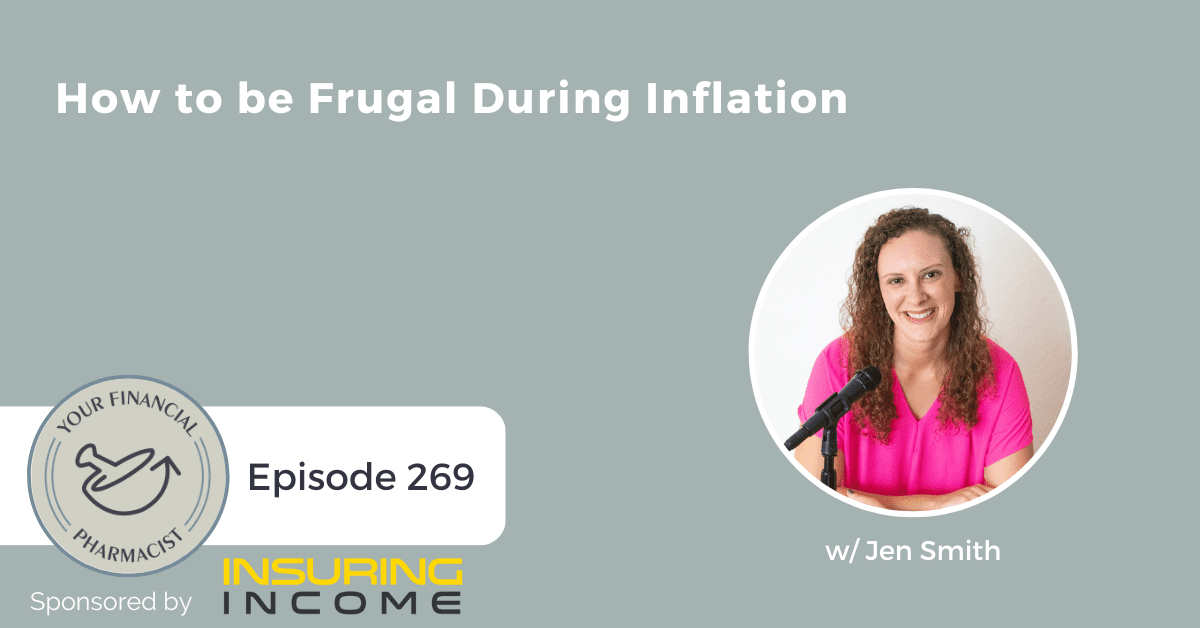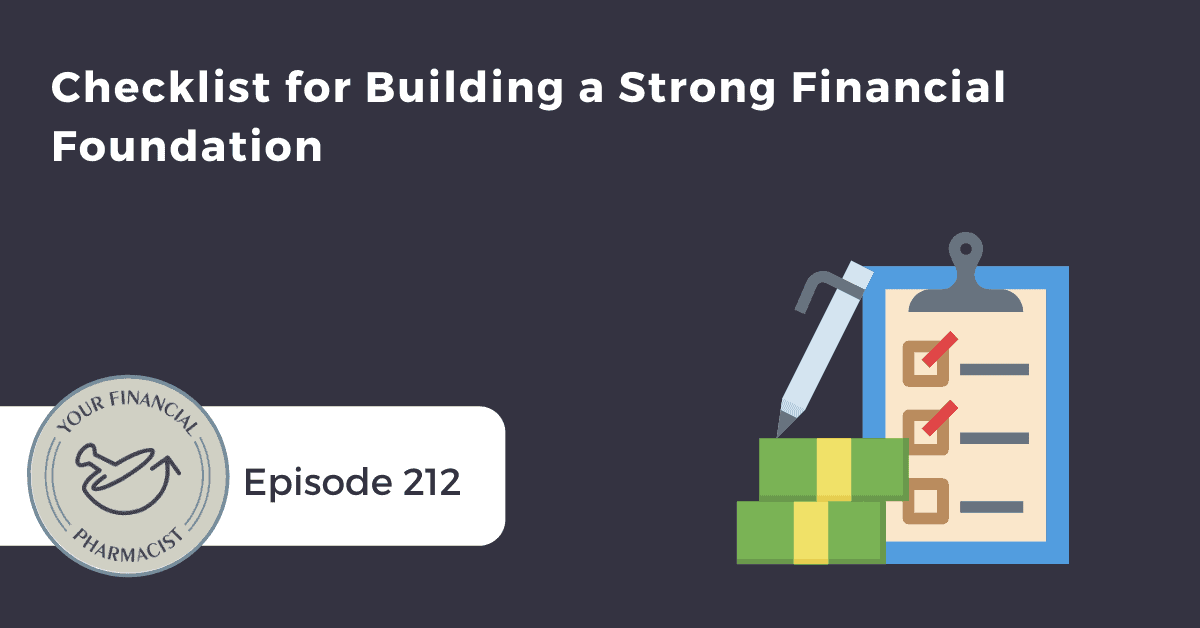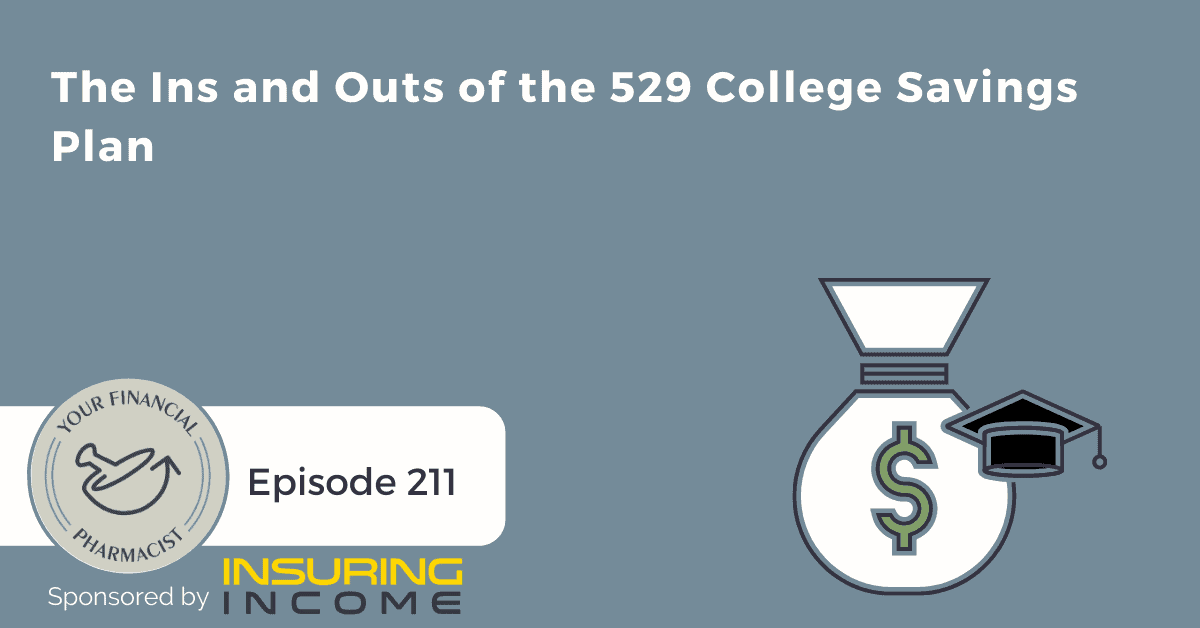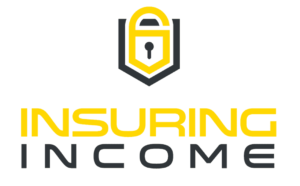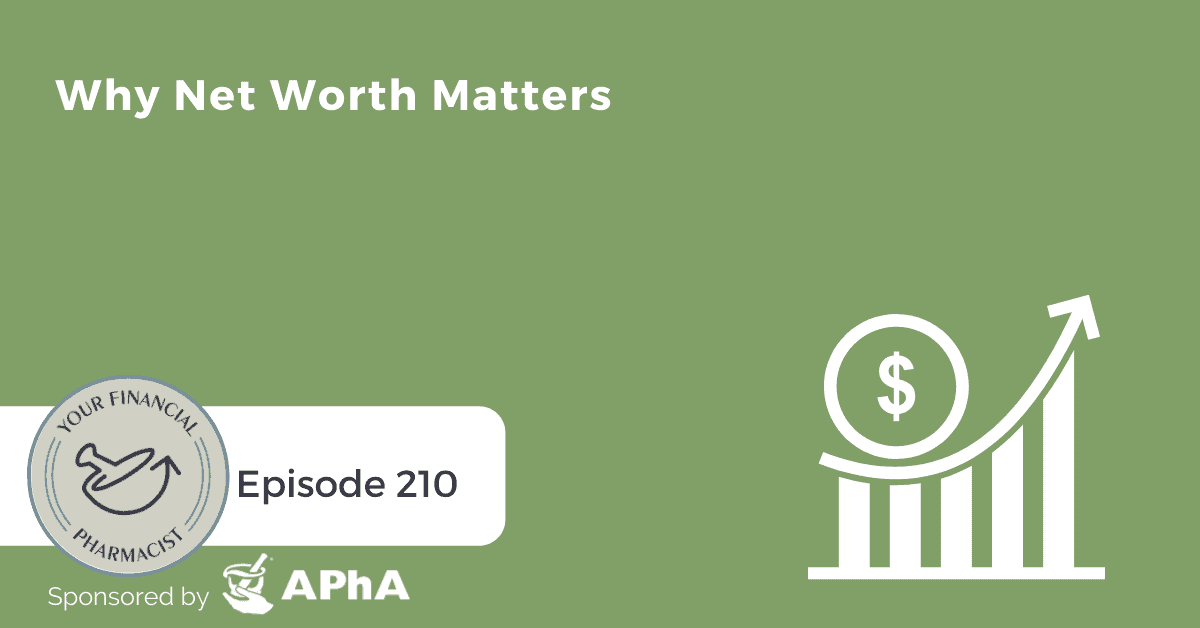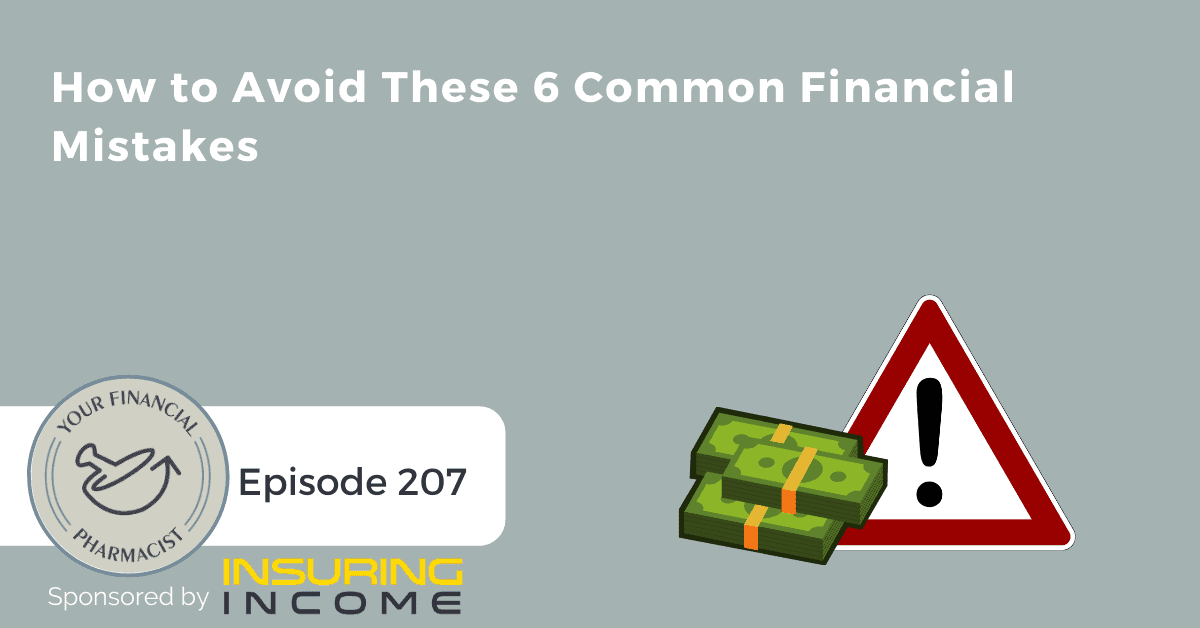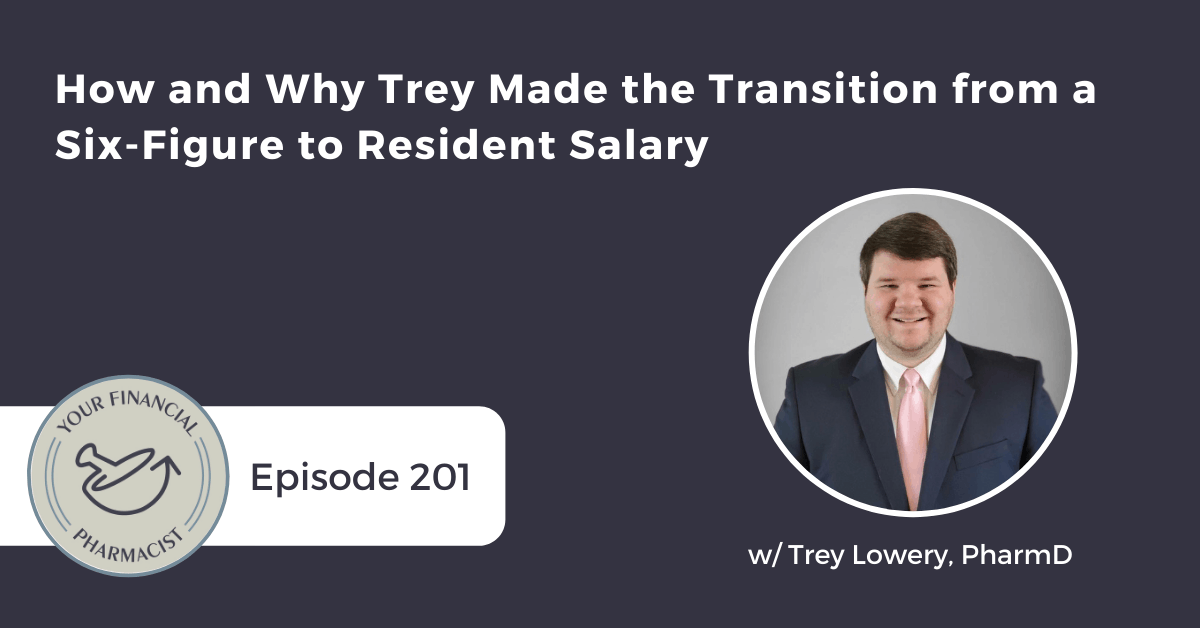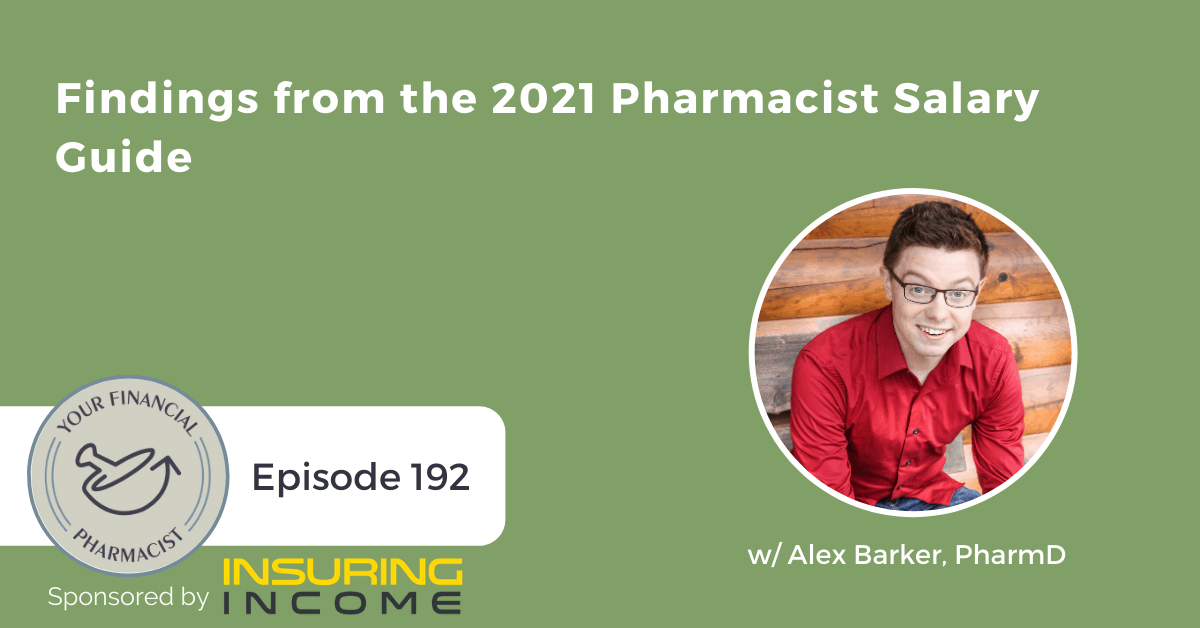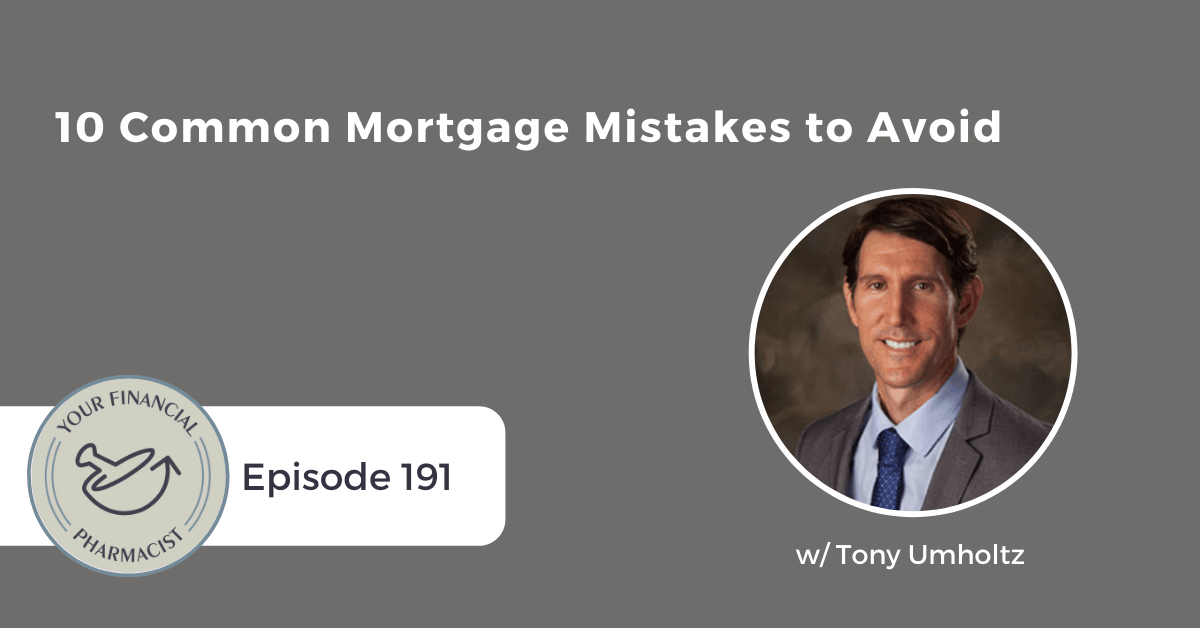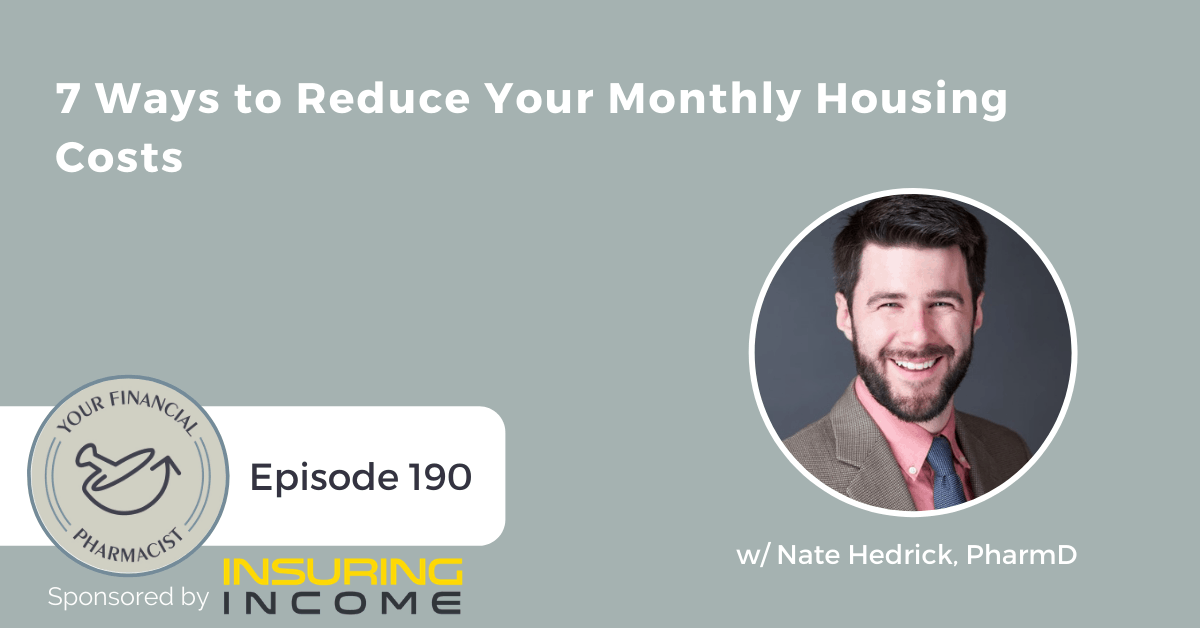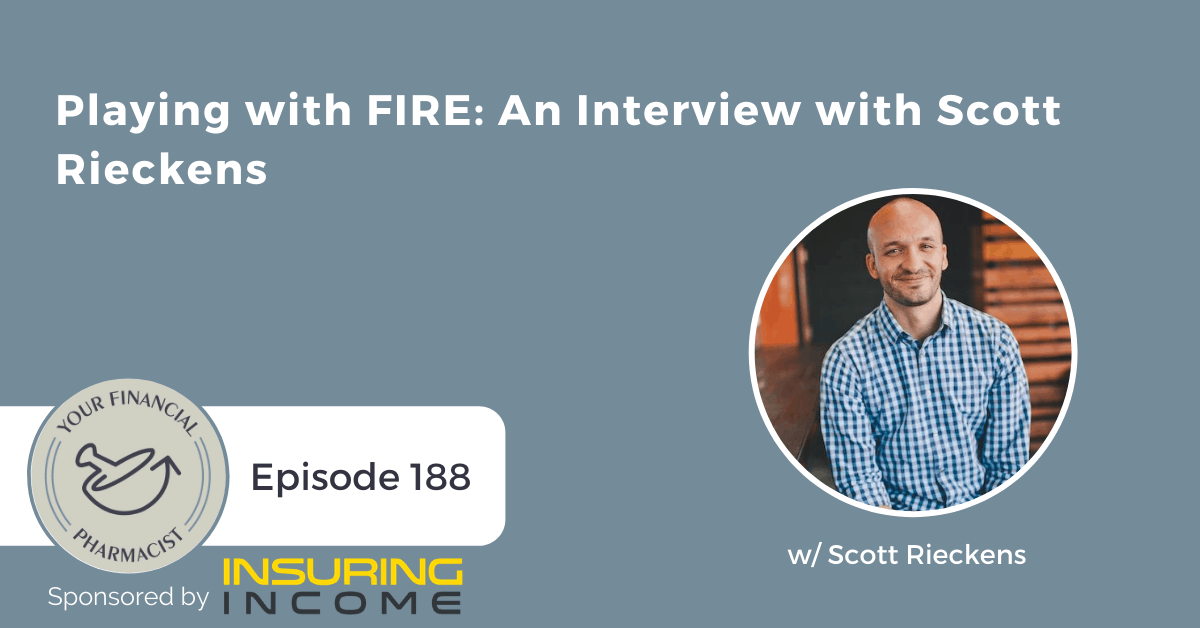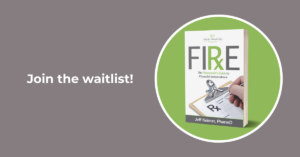How to be Frugal During Inflation
On this episode, sponsored by Insuring Income, Jen Smith, a personal finance expert and co-host of the Frugal Friends Podcast, discusses strategies to practice frugality in a high inflationary period, how she was able to pay off $78k in debt while battling unemployment, and strategies for listeners to explore whether you are looking to get organized, make additional income, or grow in your investing journey.
About Today’s Guest
Jen Smith is a personal finance expert and co-host of the top-rated Frugal Friends Podcast. Since paying off $78K of debt in two years Jen has been on a mission to help people spend in alignment with their values and live for today while saving for tomorrow. She’s the author of two best-selling books on controlling your spending and paying off debt, The No-Spend Challenge Guide & Pay Off Your Debt For Good.
Episode Summary
This week, Your Financial Pharmacist Co-Founder & CEO, Tim Ulbrich, PharmD, sits down with Jen Smith, a personal finance expert and co-host of the top-rated Frugal Friends Podcast. After paying off $78K of debt in two years, Jen has been on a mission to help people spend in alignment with their values while saving for tomorrow. She is the author of two best-selling books on controlling spending and paying off debt, The No-Spend Challenge Guide & Pay Off Your Debt For Good.
Tim and Jen discuss strategies to practice frugality in a high inflationary period and how to spot and cut out unintentional spending. Jen shares her journey to paying off $78K in debt while battling unemployment and how getting on the same page with her partner, addressing her apprehension on debt repayment, and making intentional choices in her spending changed her mindset about money. Fighting lifestyle inflation with a “radical middle approach” worked for Jen, but she recommends each person find the debt repayment strategy that works for them. Jen closes with some frugality strategies for listeners to explore, including having exploratory conversations with your partner about financial goals, taking inventory of all of your accounts, planning out financial goals annually, and automating your money where possible to prevent unnecessary spending.
Links Mentioned in Today’s Episode
- YFP’s Employee to Entrepreneur Virtual Summit: Learn More and Register Here
- Insuring Income: Get Quotes and Apply for Term Life and Disability Insurance
- Frugal Friends Podcast
- The No-Spend Challenge Guide: How to Stop Spending Money Impulsively, Pay off Debt Fast, & Make Your Finances Fit Your Dreams by Jen Smith
- Pay Off Your Debt for Good: 21 Days to Change Your Relationship With Money & Improve Your Spending Habits So You Can Get Out of Debt Fast by Jen Smith
- Modern Frugality
- Freecreditreport.com
- Credit Karma
- Automate Your Money
- YFP 057: The Power of Automating Your Financial Plan
- Get Your Free Copy of the Modern Frugal Living eBook
- Your Financial Pharmacist Disclaimer and Disclosures
Episode Transcript
[INTRODUCTION]
[00:00:01] TU: Hey everybody, Tim Ulbrich here. And thank you for listening to the YFP Podcast, where each week we strive to inspire and encourage you on your path towards achieving financial freedom.
This week, I had the pleasure of sitting down with Jen Smith, a personal finance expert and cohost of the top-rated Frugal Friends podcast. Since paying off $78,000 of debt in two years, Jen has been on a mission to help people spend in alignment with their values and live for today while saving for tomorrow.
She’s the author of two bestselling books on controlling your spending and paying off debt. The No Spend Challenge Guide, and Pay Off Your Debt for Good. During the show, we discuss strategies to practice frugality in a high inflationary period, how she was able to pay off $78,000 in debt while battling unemployment, and strategies for listeners to explore, whether you’re looking to get organized, make additional income, or grow in your investing journey.
Before we jump into the episode, I’m excited to share that we’re doing our first ever virtual summit, The Employee to Entrepreneur: Building Blocks for Growing Your Business. The Employee to Entrepreneur Summit is designed for pharmacists who are planning or actively working on a side hustle or business idea.
This summit is going to be live via Zoom evenings of Tuesday, August 30th; and Wednesday, August 31st. Topics and activities include honing your mindset and uncapping your potential. How to grow a business from a position of financial strength? Retirement savings and tax optimization strategies as a small business owner, how to develop a system for achieving business financial goals, examples of pharmacists that are monetizing their clinical expertise, and much more.
And for those that register by August 23rd, we have three exciting bonuses. Those include a one-on-one implementation meeting with myself, or certified financial planner, Tim Baker. Access to a live goal-setting workshop that I’ll be hosting after the summit. And on-demand access to several bonus interviews, including evaluating health care, insurance options, marketing strategies, how to sell with confidence and more. Lots of information that we’re going to be sharing. You can learn more and register yourfinancialpharmacist.com/businesssummit. Again, yourfinancialpharmacist.com/businessssummit.
Okay, let’s hear from today’s sponsor, Insuring Income. And then we’ll jump into my interview with author, blogger, and podcaster, Jen Smith.
[00:02:19] TU: This week’s podcast episode is brought to you by Insuring Income. Insuring Income is your source for all things term life insurance and own-occupation disability insurance. Insuring Income has a relationship with America’s top-rated term life insurance and disability insurance companies so pharmacists like you can easily find the best solutions for your personal situation.
To better serve you, Insuring Income reviews all applicable carriers in the marketplace for your desired coverage, supports clients in all 50 states, and makes sure all of your questions get answered. To get quotes and apply for term life or disability insurance, see sample contracts from disability carriers, or learn more about these topics, visit insuringincome.com/yourfinancialpharmacist. Again, that’s ensuringincome.com/yourfinancialpharmacist.
[INTERVIEW]
[00:03:10] TU: Jen, welcome to the show.
[00:03:12] JS: Hey, thanks for having me.
[00:03:13] TU: I’m really excited to have you here and to hear more about your debt payoff journey. And we’ll talk about that. But first, I’d love to learn more about your career background and the work that you’ve been doing with Frugal Friends and Modern Frugality.
[00:03:27] JS: Yeah. My frugality journey started back in 2015. I was about three years out of my master’s program. My degree is in acupuncture and oriental medicine. But it was a much more expensive degree than the income provided. So, I was very much ignoring my student debt. And I thought I was frugal, or I thought I was responsible because I would buy the generic products at the grocery store. But I would also turn around and like get Chipotle on the way home from the grocery store and go out and get Starbucks without thinking about it. There was definitely a disconnect between what I thought like financially responsible was and what it really is.
So, in 2015, I got married and my husband said that he wanted to pay off his student loans, and I wasn’t as motivated, but I felt guilty because my student loans were double what he had. When we got married, we started on this journey to pay off $78,000 of debt. And I realized pretty quickly that I couldn’t side hustle my way out of it. That’s really what I tried to do at first. And I got shingles two months into trying to side hustle my way. Yeah, from all this stress, and at the ripe age of 26.
That’s when I realized I needed to be more were intentional about my spending. Not just paying attention to like what’s generic or maybe what’s like $1 cheaper than something else. Very intentional about my overall spending. And it very much freed up so much of my life. I thought it was going to be full of deprivation. I was an adult. I didn’t want anybody to tell me what I could and couldn’t do, much less me telling me what I couldn’t do.
But I found that being intentional and spending on the things that I value versus things that I didn’t think about gave the sense of freedom. And it’s really what allowed us to pay off $78,000 in two years on really average. Because we never made more than $88,000 a year combined. And so, after that, a few years later, I met my cohost, Jill, for the Frugal Friends podcast. And she and her husband were thinking about starting a podcast. And her husband wanted to produce and edit it. And I was like, “I’ll never start a podcast, because I’m a writer.” I had my Modern Frugality blog. But if I did, it’d be called Frugal Friends, because I love alliteration. And they took that as a sign to just start producing it. And four and a half years later, 227 episodes in, we have never missed a week of recording. And it’s been like one of the greatest joys of my life.
[00:06:30] TU: I love that. And we’ll link in the show notes of the Frugal Friends podcast, as well as your blog, Modern Frugality.
My question, Jen, around frugality. When I talk with those that are within the first, let’s just say, 10, 15 years of their career, I feel like the words budget and frugality feel like no-no words. Just things that we don’t love to hear. You mentioned kind of that restrictive. It can have that restrictive feeling. And so, my question is how are you making frugality exciting? Obviously, you’ve built a community, you’ve built a brand around it. Of course, that is resonating on some level with folks. Why do you think there’s a movement around this concept of frugality?
[00:07:11] JS: Yeah, because until you know what’s enough for you, nothing will ever be enough. And so, you’ll keep on this rat race, on this treadmill, looking for what is going to fulfill you. And you’ll keep buying more and looking to make more. And more time with family. More of this. More of that. And like, unless you realize what you truly value, what’s enough in these other places so you can have more in places you care more about, nothing will ever be enough. And it will be this continual unfulfilling race, which is exhausting, which is why so many of us are exhausted, like, 10, 15 years out of college. Because we thought we’d have it more figured out. But it’s so rare to do the work upfront of figuring out like, “Who am I? What do I want? What do I want that’s maybe unconventional? And how do I create boundaries to pursue that more easily?” And then just to do the hard work of retraining your brain to pursue those things, versus immediate gratification.
[00:08:26] TU: As you think about the time period that we’re in, my family is feeling this firsthand. I mentioned to you before we hit record, I’ve got four young boys that are literally eating me out of the house right now. And we’re in this time period of not only high inflation, groceries are wild as well. And I’m sure this topic of, how can I practice frugality in a day when inflation is through the roof? Things are so expensive. What advice would you have for folks that are feeling the pinch month-to-month given the price of goods, of gasoline, of food, and everything that’s going on, but want to be intentional? That concept of frugality. Of being conscious with how we spend. Of making sure we’re living that rich life today while we’re taking care of our future self. That resonates, but there’s the reality of the here and now.
[00:09:09] JS: Yeah. Well, we all want to be more responsible with our money. We want to all have more money left at the end of the month saved. And I think when we start thinking about budgets, and saving, and cutting expenses, we always jump to the things that we love most. Like, when I first started paying off debt, I was thinking, “I don’t want to get on a budget. I don’t want to do this.” Because I don’t want to cut out having dinner with friends. Like, community is one of my core values. And so, that was the first thing I jumped to.
Usually, it’s the first thing you think of is the last thing that you should cut out. When you are pursuing frugality and intentional spending, you want to look through all of your transactions in your bank account, and find the things you’re spending money on that you don’t even realize you’re spending money on. So, maybe a subscription that raised in price, or a subscription you’re not using it all, or these trips to the gas station where you’re going inside and you get a candy bar or a soda with your gas purchase. It’s stuff like that you are doing mindlessly that you don’t really care about, but you kind of probably don’t even realize you’re doing it. It’s those things that we cut out first. And it’s easier to retrain your brain to cut those things out than it is the things you care most about.
[00:10:35] TU: Yeah. I think, too, what I found in my own journey, Jen, that resonates with what you’re talking about around conscious spending. And you gave that Chipotle example earlier, right? Which I think was a really good one coming back from the grocery store. Like, guilty as charged.
And I think that, to me, it’s about the dollars, yes, because maybe we can allocate those towards another part of the plan and be more intentional with them, especially if it’s unconscious spending. But it’s also about that feeling of like, “I’m in control. Like, I’m mindfully spending my money,” right? And I connect this to a lot of eating patterns and behaviors as well. But if we’re going to make a splurge financially, let’s do it consciously, right? Let’s make sure we’ve thought about it. We’ve prioritized it. We’ve considered it among the rest of our financial goals in our plan. And then we’re not unconsciously making those decisions.
And I think what resonates with me of what you’ve shared in some of your blogging materials is that the financial plan, as we think about as a continuum over our lives, is really this balance of living for today while saving for tomorrow. Right? We talked about inside YFP, is we need to be saving and taking care of our future selves. But we also need to live a rich life today. And so, there’s nothing wrong with us spending money. But we want to do it consciously. We want to do it intentionally. And I love what you’re sharing as it relates to that and make sure we’re being intentional in how we’re spending our money.
[00:11:53] JS: Yeah, absolutely. That’s the only way to keep it sustainable, because you are – You’re not promised tomorrow. But also, you’re not promised that you’re going to die when you’re 70. You have to plan past that. But you also want to make the most of your todays. And that’s why I think it’s so important that you sit down and figure out, like, “What do I value most? What are the things that I love the most I want to pursue? And what am I going to say no to so that I can pursue the things I love more?”
[00:12:28] TU: When we think about lifestyle inflation, I think this is something that is so common in society at large, but especially as I think about our profession of pharmacy. Often, folks will spend six to eight plus years in school to get their doctor pharmacy degree. They’ll walk out with 170,000 something dollars a debt. They might go directly into a good six figure income or perhaps have a stepping stone with a residency. And I think that jump in salary can really lead to significant lifestyle inflation. And obviously, we have high costs of just what is reality today with homes and everything else.
Are there one or two things that you typically see, and whether it’s your own journey or your community that, is often contributing towards that lifestyle inflation that folks should be on the lookout for?
[00:13:14] JS: I think it’s the feeling of I’ve accomplished so much. I’ve graduated with this degree. I’ve gotten this job. I have done the hard work. And now it’s time to reap the benefits. And that’s the mindset. I had the same mindset when I graduated. And I think there’s nothing wrong with saying like, “Yes, you deserve a higher quality of living than when you were like eating ramen or whatever in college.” Yes, absolutely. But it can be really beneficial to commit to at least two years after college to say, “Hey, I’m not going to live like I lived in college. But I’m not going to live in the full potential.” Because the earlier you start paying off your debt and investing, you essentially are saving money on buying your freedom. The earlier you start, the more time you have to compound your savings in your retirement accounts. And the less money you’re going to pay in interest on your debt.
The earlier you start that, you will purchase your freedom for a lot less money than if you “enjoy your accomplishments early”. And then 5,10 years down the road, you’re like, “Oh, crap. What have I done? What have I spent all this money on?” And even if you are 5, 10 years down the road, committing for two years, give or take, whatever your situation is, to really focus on getting money into your retirement accounts, getting at least higher interest debt paid off, is really going to benefit you in the long run.
[00:15:02] TU: And so, as relates to this mindset change, you mentioned in your journey that was something that you encountered as well. As you ultimately paid off $78,000 of debt in two years, what was the turning point for you? When did you start thinking, “Okay, Jen, we really need to make a plan to tackle this?” What changed?
[00:15:21] JS: It was my fiancé at the time, now husband, saying, “I don’t care what you’re going to do. I’m going to pay off my student loan.” He wasn’t going to force me. And so, I always say, if you have a spouse that’s not onboard, you cannot force them onboard. But he was going to take it upon himself to do his thing. And then he also encouraged me to think about, what are the things you want to do long term? And how much easier could they be? How much sooner can you accomplish them if we just spent a few years upfront getting rid of this debt?
He really challenged me to think about that, because there were dreams and goals that I had. And I was like, “Yeah, it would be a lot easier if I had the option of working. If I didn’t feel forced to have a nine to five job, but I could have flexibility in that, these things would be a lot easier.” And so, that inspired me, and convicted me, and challenged me to convert.
[00:16:26] TU: I love that. Because it’s the vision, right? Start with the vision and the dream. And then you back into the details and you get excited. But, folks, if you jump in your studentaid.gov profile and you start inventorying your loans, and you look at your private and your fed, like, it’s overwhelming, right? It’s very overwhelming, especially if folks have a couple $100,000 in debt. But if you can begin with, “Okay, deep breath. I’ve got this mound of student loan debt.” The past is what it is at this point. Let’s focus on what we can control going forward. And how can we begin to think about the vision for what we want for our lives, for our financial plan that ultimately will support the debt repayment strategy?
And so, for you and, at the time, your fiancé, now husband, what was the strategy? How did you do it? There’s the snowball approach that folks talked about. There’s the avalanche method. You mentioned a side hustle. Like, what was the actual strategy for how you’re able to pay off that debt?
[00:17:19] JS: Yeah. We took a little bit of everything. And that’s why, on our show, we’re big proponents of being in the radical middle. Everybody wants to take an extreme to where, being in the middle and choosing your own path is very radical. That’s really what we support. And so, we did a little bit of – We started with the debt avalanche. And then in my student loans, there were a lot of different – They were all the same interest rate. But there were a lot of different sizes. I don’t know. Some semesters, I was poor, I guess. And so, we would do the snowball within that. All of Travis’s interest rates were different. So, then we did the avalanche there.
And so, we kind of just did what worked for us. And we just took it month by month. And we thought it was going to take us five years to pay off our student loans. Because Travis was unemployed when we started. We were not at a great financial place when we started. I got 25 hours a week at work, max. I had to find like a side job and side hustles. Travis started with side hustles while he was looking for a full-time job. We were definitely not in a place where anyone would have recommended us start paying off our debt. But we did it anyway. And we just took it month by month. And every month, built on itself. We got a little bit more every month being put towards debt, until Travis got employed. And we were putting just my entire paycheck towards debt every month and just living on his.
And so, that was kind of the strategy. We just went little by little until we were putting one whole income to debt and living off the other. I mean, even if you’re in a single-income household, I mean, we were making $88,000 max. That was like 44 plus thousand per year. And we were living – It was a lot lower cost of living at that time. Gosh! It’s crazy to think about just seven years ago. But we were able to put a significant portion down on our debt because we chose maybe not the most ideal living situation. And we’re just really intentional about every penny we spent.
And we are not as intentional as we were. We’re not as intentional now as we were then, because we really had a goal that we were focusing on. And like I said, focus on one year, two years to see how much you can get out of the way. Don’t look at all six figures of your debt and say, “I can’t do this.” Because that’s what I did at first. I looked at my debt and I was like, “This is almost double what I make in a year. There’s no way. I’m just going to ignore it.”
But if I had taken just a year, a month by month or a year by year approach, I probably would have started sooner and just said, like”, “Okay, how much can I get this year?” And just made it my goal to like go hard. And then the next year, maybe, “Okay, how much can I get here in this year? But maybe I’m going to also focus on my IRA or my 401k and see how much I can get and add in here.” And if you do that, you focus on the month to month, quarter to quarter, year to year, you’ll make a bigger snowball effect than if you’re looking at it as a whole.
[00:20:44] TU: I really liked the concept of the radical middle. I like that a lot. Because I think that we see that and conversations I have with folks who have strong opinions on debt repayment, right? Versus investing or saving for the future. There’re strong opinions on how much should I put down on a home? And you kind of put people in opposite corners.
I think, for everyone, what we realized when you get to individual conversation, like, as my partner, Tim Baker often says in the podcast, like, it depends. It depends on what your financial situation is. How do you emotionally feel? Whether it’s about debt, or saving, investing for the future. What else is going on in relation to the financial plan? And then from there, we can craft a plan that we feel comfortable with. So, I think that’s a really, really good approach.
For folks that are listening, I’m thinking of spouses, significant others, partners that maybe aren’t on the same page with a given topic. You mentioned your journey and your fiancé, now husband, at the time was like, “Hey, I’m moving forward on this, whether you are or not.” And obviously, that left you is kind of making some decisions. And ultimately, you guys getting on the same page. But I think it’s not uncommon that you may have someone that’s on fire about a financial goal, or a budget, or debt repayment, or saving for the future. And someone else may or may not be in that same boat that that other person is. From your experience in your community, what advice would you have for folks that are really trying to, “Let’s get on the same page and make sure that we share in the vision going forward?”
[00:22:13] JS: Yeah. There’s a number of reasons why a partner might not want to get on board. I think the first thing to do is instead of trying to convince them in the way you were convinced, figure out why they’re apprehensive. Some people, it’s like, they don’t like being told what to do. Some people love spending money in the here and now. Tomorrow’s not promised. They want to spend it now. Some people just get anxiety about money. They don’t want to think about it at all. There are so many reasons. And I think your partner may not even know what the reason is.
And so, just sitting down and figuring out like what are our collective goals individually and together? What do you want? And how can we get there. And I think as you start to have more of these explorative conversations, the reasons for the disconnect will start to come up. Whether you’re talking about like their childhood, or they didn’t have a lot growing up, and they want to enjoy what they have now, because they worked really hard for it. All this stuff like that. It starts with exploratory conversations about the future. Trying to figure out what from their past is making them apprehensive to adopt frugality. Because nobody wants to feel deprived. Everybody wants to feel good and confident about the way they manage money even your partner who may not be on board with paying off debt. There’s just some kind of disconnect, where maybe what you’re saying or what you’re thinking is different from the reality that you want to put forward. But you can’t force them in typically with numbers, or force like a lot of the force thing that sometimes I hear about. It is really more of like a pull and a push.
[00:24:06] TU: Yeah, I think that’s great advice. And especially for folks that might be listening to the podcasts or more of that financial nerd camp, like, if you got energized by the calculator, like that doesn’t necessarily mean that your significant other is, right?
[00:24:22] JS: Yeah. They probably are not.
[00:24:23] TU: Probably are not. Yes, exactly. On the blog, Modern Frugality, I think you do a really nice job of identifying folks that may be in a few different areas based on their goals. So, folks that are feeling like, “Hey, I need to get organized.” Folks that are wanting to make some extra money, could be side hustles, businesses. And then folks that are wanting to get started with investing. And so, I want to focus on two of those here for a few moments.
And that first one of I need to get organized, is there a tip or two that you could share for individuals that are just feeling overwhelmed, and maybe that organization step would be really helpful for them to be able to clear some of the fog to then move forward with their financial goals? Where do you start with organization?
[00:25:05] JS: Yeah. The first step is to figure out all of your accounts, your debts, everything. And you can do that by getting your free credit report either at freecreditreport.com or something like Credit Karma. And this is the report. Not the score. We’re not as concerned with the score right now. But your credit report will have a list of all of your debts, all the accounts you have open, and the amounts, like balances for each. If you look at that, and it’s not there, then it’s not there. It’s not associated with your social security number.
And so, when you look at that, it really gives you a whole picture of, “Okay, I am this much in debt. I have this much in my savings. This is where I’m at.” And so, it’s nine times out of 10 not as scary as you think. And some people just don’t want to gather everything because they don’t know where to find it. It’s like, “Where can I find everything?” It’s in your credit report.
And then next is just to look at your transactions. So then go to those checking and savings accounts and look at your transactions from probably the last three months. Which ones did you love and you feel good about? Which ones do you not remember making? The ones that you did not remember making or did not feel good about, those are the ones we cut out first. And you write down on a piece of paper, “I will no longer spend money here or on this for this reason.” And then we don’t spend money on those things anymore. And the things that aren’t on that list, you can spend money on without guilt.
And then as you go and you start to think, “Okay, well, this wasn’t on the list before. But I think I might be able to add it. Or maybe this was on the list.” And actually, do enjoy this for reasons I wasn’t thinking about earlier, we take it off the list.
But as you go, and you make baby steps towards intentional spending, we don’t start with those things that we love the most. We start with the things we don’t care about. And that’s how we make these steps towards financial freedom and intentionality.
[00:27:13] TU: As I’m going through this exercise, if I identify there’s maybe more unconscious spending that I would like there to be, what are some strategies that might help me bring some more awareness and consciousness to that spend? You’ve identified one. I think, if I’m hearing correctly, I’m writing these down, journaling them. Other people talk about using cash for a small period of time, which is not super convenient in 2022. Are there other strategies that you have found personally or you see in your community that helps increase the awareness and the conscious level to spending?
[00:27:47] JS: Yeah. I talked about baby steps. But actually, my favorite way to like shortcut this is to do a no spend challenge, which is the opposite of baby step. But it’s like short term. I would take a month. And challenge yourself to not spend any money on discretionary purchases. We’re still paying bills. We’re still paying mortgage. We’re still putting gas in the car to get to work. But it’s the discretionary things. It’s everything else.
In the grocery store, if it’s not in the list, we don’t buy it. It’s meal planning for everything. And you can even schedule like one or two meals out during the month. But if they’re not scheduled, they don’t happen. It’s saying no to – For like an actual no spend challenge, I would say no. When I was doing them, like no eating out, no coffee. Just anything discretionary. Because it helps when you are at the end of the day, and you’ve made good decisions all day. And you get to five o’clock and your brain is tired. It is done making good decisions. It’s done making the right decision. And that’s when you start you get decision fatigue, and you start to make the wrong decision when you have the option. When you’re on a no spend challenge the answer is always no. And so, that’s one – It’s decisions you don’t have to make, because you’re challenging yourself to say no to everything.
And I know some people will try and do pantry challenges while they’re on a no spend challenge. Only eating from their pantry and fridge and freezer during that month.
[00:29:20] TU: Ah! Get creative. Yeah. Yeah.
[00:29:22] JS: Right? I never carried enough in my fridge and freezer, nor have I ever had a full pantry to do that. But if you feel like you’re a little overstocked in your kitchen, another great way to not spend money. But once you do this for a month, you will get a really eye-opening view of what you care most about. What things you don’t even realize that you are giving up? Things you didn’t care about.
And so, you can go forward after the challenge to say, “Okay, these are the things I’m going to spend on without guilt. These are the things I’m giving up. Saying no to.” And it really just fast track that process.
[00:30:02] TU: One of the things that you’ve written about that we talk a lot about on our show is the concept of automation. And I’ll link in the show notes. We talked about this on episode 57, way back when, in the power of automating your financial plan. And you had a blog post that we’ll link to as well in the show notes on automate your money. Can you tell us about, from your perspective, what does automation mean when it comes to the financial plan? And why is it so valuable to help someone in achieving their financial goals?
[00:30:29] JS: Yeah. Well, it kind of comes back to the decision fatigue. Again, when you have to make the decision to pay a bill, you may forget, because you may have made too many decisions, and it just slipped your mind. Or the decision to put money into your 401 (k) or IRA, you may not put as much in when you’re in the moment when something just put you over budget or you had like a surprise expense from your kid, then you tend to invest less or put less towards debt.
We want to take that decision off the table. Make your spending plan for the year. Figure out how much you can feasibly afford to invest or pay off debt every month, and just automate it. It’s one less thing that you have to worry about. You can automate it for soon after you get paid. It’s very easy if it’s like first 15th on Fridays. I mean, you can sometimes change when your bills are paid so they line up better with your payday. But sometimes it’s just easier to get that money out of sight out of mind. For someone like me, I used to spend every penny that was in my account if I saw it. Now, everything leaves the account and goes to savings, investing or mortgage before I have the opportunity to spend it. So, then I look at my account and I’m like, “Oh, cool. I can spend all this money if I want. Or I don’t have to. Whatever.” But yeah, automating just takes that decision off the table. And it just – I mean, aside from allowing us to be lazy, who doesn’t want to be lazy when it comes to money? It’s so much easier to not have to think about it. But even when it comes down to the decisions of how much we put towards debt and how much we invest, much easier to make a neutral decision via a plan than an emotional decision in the moment.
[00:32:26] TU: Absolutely. One of things I love about automation is it forces you to be intentional, right? We talked about that earlier. But if you’re going to be proactively planning and setting up some of these systems around automation, we’ve got to define the goals. We’re already looking at the budget and expenses. We’re those funds towards different buckets and the goals that we’ve identified. It really forces our hand to make sure that we’re being intentional, and obviously increasing the amount of conscious spending that we’re doing.
Jen, this has been great. I really appreciate you taking the time to come on the show. Where is the best place that our listeners can go to find you and to connect with you further?
[00:33:00] JS: Well, wherever you’re listening to this podcast, you can find Frugal Friends podcast. We release a new episode every Tuesday and Friday. And we also have an ebook with over 200 ways to save money. And that’s at frugalfriendspodcast.com/ebook. Yeah. And then we talk more about intentional spending on the show. So, it’s a full circle.
[00:33:22] TU: Thank you so much, and I appreciate it.
[00:33:24] JS: Yeah, thanks for having me.
[00:33:26] TU: Before we wrap up today’s show, let’s hear an important message from our sponsor, Insuring Income. If you are in the market to add own-occupation disability insurance, term life insurance, or both, Insuring Income would love to be a resource. Insuring Income has relationships with all of the high-quality disability insurance and life insurance carriers you should be considering and can help you design coverage to best protect you and your family.
Head over to insuringincome.com/yourfinancialpharmacist. Or click on the link in the show notes to request quotes, ask a question, or start down your own path of learning more about this necessary protection.
[OUTRO]
[00:34:02] TU: As we conclude this week’s podcast, an important reminder that the content on this show is provided to you for informational purposes only and is not intended to provide and should not be relied on for investment or any other advice. Information in the podcast and corresponding material should not be construed as a solicitation or offer to buy or sell any investment or related financial products. We urge listeners to consult with a financial advisor with respect to any investment.
Furthermore, the information contained in our archive newsletters, blog posts and podcasts is not updated and may not be accurate at the time you listen to it on the podcast. Opinions and analyses expressed herein are solely those of Your Financial Pharmacists, unless otherwise noted, and constitute judgments as of the dates publish. Such information may contain forward-looking statements, which are not intended to be guarantees of future events. Actual results could differ materially from those anticipated in the forward-looking statements. For more info information, please visit yourfinancialpharmacists.com/disclaimer.
Thank you again for your support of the Your Financial Pharmacists podcast. Have a great rest of your week.
[END]
Current Student Loan Refinance Offers
[wptb id="15454" not found ]Recent Posts
[pt_view id=”f651872qnv”]

